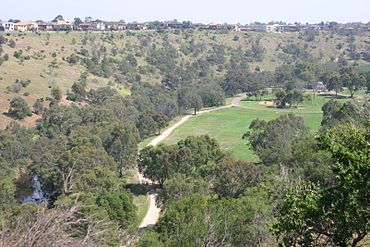Keilor, Victoria
| Keilor Melbourne, Victoria |
|||||||||||||||
|---|---|---|---|---|---|---|---|---|---|---|---|---|---|---|---|

Brimbank Park
|
|||||||||||||||
| Location in metropolitan Melbourne | |||||||||||||||
| Coordinates | Lua error in package.lua at line 80: module 'strict' not found. | ||||||||||||||
| Population | 5,759 (2011 census)[1] | ||||||||||||||
| • Density | 351.2/km2 (909.5/sq mi) | ||||||||||||||
| Postcode(s) | 3036 | ||||||||||||||
| Area | 16.4 km2 (6.3 sq mi) | ||||||||||||||
| Location | 18 km (11 mi) from Melbourne | ||||||||||||||
| LGA(s) | |||||||||||||||
| State electorate(s) | |||||||||||||||
| Federal Division(s) | Calwell | ||||||||||||||
|
|||||||||||||||
Keilor is a suburb of Melbourne, Victoria, Australia, 18 km north-west of Melbourne's central business district. Its local government areas are the Cities of Brimbank and Hume. At the 2011 Census, Keilor had a population of 5,759.
Whilst most of the suburb is contained within the City of Brimbank, the northern section of Keilor, north of the Calder Freeway, is within the City of Hume. This section of the suburb is located on the flood plain of the Maribyrnong River, and is home to many market gardens.
The suburb is essentially residential with large industrial developments in adjacent suburbs.
There are several shopping centres in the area including Keilor Shopping Centre and Watergardens Town Centre approximately 5 km away.
History
Keilor is a township in a basin of the Maribyrnong River. James Watson from Scotland was the first land-holder in the district. Keilor in the early times of the gold diggings was a noted camping place for bullock teams to and from the diggings at Castlemaine and Ballarat. Caroline Chisholm was responsible for having shelter sheds erected alongside the river; a reconstructed example has been built and may be viewed. The escorts from the goldfields passed through Keilor. They camped in a paddock near Keilor. This paddock was known as Escort Paddock and the remains of an old stone building is still to be seen there. The surrounding country is known by the name of the Keilor Plains and is of basaltic formation. Spanning the river was a wooden bridge which was replaced by an iron bridge in 1868. A new bridge had been built alongside the iron bridge. Both the Anglican and the Catholic Churches built during the early settlement years have been retained for future generations to view and to enjoy. They have been heritage listed.
About 1 million years ago lava covered the previous landscape and created basalt plains. Over time, the Maribyrnong River carved itself through the basalt plains.
Australian megafauna including 3 metre high kangaroos and Diprotodons were found in the area until extinction about 13,000 years ago at the end of the ice age.
The Wurundjeri Aborigines inhabited the area for approximately 40,000 years. It is one of the oldest inhabited sites in Australia.
The first Europeans to pass through the area were Charles Grimes surveying party who followed the Maribyrnong River upstream in the Summer of 1803. Grimes report of the area was unfavourable. In June 1835, John Batman followed a similar route and remarked of Keilor that it was the "Most beautiful sheep pasturage I ever saw in my life".
In about 1838-39 the first European settlements were established by pastoralists James Watson and Alexander and John Hunter. James Watson is thought to have named their home station after a farm called Keillor <sic> in Forfarshire, Scotland, one of four which his father, Hugh Watson, tenanted.[2]
In the 1850s people would stopover at Keilor during their travels from Melbourne to the Bendigo goldfields.
One area in particular for these stop overs was known today as Yarra court, the direct path to proceed was across the back of the court where a property has resided for over thirty years. It has been known for many years that this house is indeed haunted by the ghosts of fallen travelers, from various sightings and recorded accounts. One particular sighting that has been recorded was that a woman can sometimes be seen standing in the double story top left hand window. The home has been occupied for over thirty years and remains one of the first homes built in the Keilor district.
Keilor saw an influx of new settlers who intended to cash in on this new market. Keilor Post Office opened on 2 March 1854 [3] and a general store, blacksmith, hotel, police station, courthouse and bridge were all built during this time.
The area became an agricultural district and remained so until after World War II when the suburb saw a rapid increase in population due to cheap land and the establishment of large industries in surrounding suburbs.
Today
Keilor Football Club, an Australian Rules football team, competes in the Essendon District Football League.[4]
Golfers play at the Keilor Public Golf Course on the Calder Highway in the neighbouring suburb of Keilor North.[5]
Notable people
- Mark Viduka, English Premier League player and former captain of the Australian National Football Team, grew up in Keilor.[6]
- Dante Exum, NBA basketball player, played for Keilor
See also
- City of Keilor — the former local government area
- Brimbank Park
- Electoral district of Keilor
References
- ↑ Lua error in package.lua at line 80: module 'strict' not found.
- ↑ Narrative of an agricultural tour in England & Scotland in the year 1840, by Count Conrad De Gourcy, in The Farmer's Magazine, September 1842
- ↑ Lua error in package.lua at line 80: module 'strict' not found.
- ↑ Lua error in package.lua at line 80: module 'strict' not found.
- ↑ Lua error in package.lua at line 80: module 'strict' not found.
- ↑ Lua error in package.lua at line 80: module 'strict' not found.
External links
- [1] Keilor Thunder Basketball - Big V
- The Keilor Historical Society
